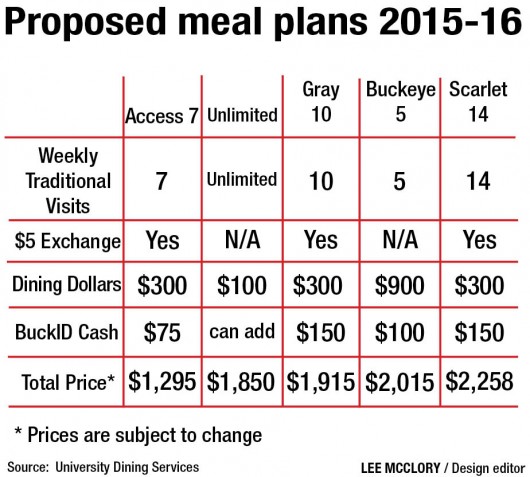Ohio State and University Dining Services have decided to take the dining plan system in a new direction for the next academic year, eliminating the block program and replacing it with one that is anchored by “weekly traditional visits.”
In an email sent last week, OSU announced that the block system, which has been in place since the quarter-to-semester conversion in 2012, will no longer be available. Instead, students will choose from dining plans that provide a set number of weekly traditional visits.
“These changes, which modify the block structure, are designed to give students the value and flexibility they want and need from a campus dining plan,” said Dave Isaacs, spokesman for the Office of Student Life, in an email.
Isaacs said the new plan was devised by numerous groups at OSU and included feedback from students.
“A number of student organizations were involved in the entire process, including the Residence Hall Advisory Council, Undergraduate Student Government, RAs (Resident Advisers) and student focus groups,” he said.
He also said the viewpoints of current students using the block system were taken into consideration, with an overall goal of making the new program a success.
The email OSU sent outlined major points of the new system and included definitions of some of the new terms.
The total visits each week differ plan to plan, starting at five per week and maxing out at an unlimited amount of visits. These visits do not roll over week-to-week, making this a “use it or lose it” system.
The visits can be used at any of the traditional dining locations, which include Kennedy Commons, Morrill Traditions and the new Scott House location that will be in the North Campus Residential District. However, the system does allow students to continue to buy food at other campus locations.
Visits can be exchanged for $5 each at any nontraditional campus dining location. This exchange works like blocks, and any money not used is lost. Students who choose the unlimited visit plan will not be able to trade visits for $5, so the maximum number of exchanges per week will be limited to 14.
Another new feature of the system is Dining Dollars, which will be automatically added to a student’s BuckID when they pay for their plan. Each plan includes a different amount of Dining Dollars ranging from $100 to $900. Students will also receive a 10 percent discount when purchasing food with the Dining Dollars, which can be used at any OSU dining facility. This money will roll over until graduation.
BuckID cash will still be included with the meal plans excluding the unlimited plan, which will only give students the option to add cash to their card. The option to pay for a meal using combinations of Dining Dollars, BuckID cash and real money will still be available.
The new system will offer five plans for students living on campus and two plans for commuter students. One plan, the Access 7, will not be offered to incoming first-year students. Isaacs said this plan is aimed at second-year students who will be encouraged to have more off-campus experiences and will not be eating in dining halls as much as first-year students.
The specifics and prices for all of the plans can be found online, but Isaacs said they are not set in stone. The dining plans and rates must be approved by the Board of Trustees, which will next meet April 9 and 10.
Although OSU hopes the new system will better cater to the needs of students, Kapil Shankaran, a first-year in chemical engineering, doesn’t think it will work.
“With blocks, you have a set number that is easy to keep track of over the semester,” he said. “Trying to keep up with the new weekly swipes and Dining Dollars seems like it will be more complicated.”
Shankaran also said the new plan seems to be trying to force students to eat at the traditions location, which he doesn’t like.
“I usually eat at different places on campus, and I don’t think the Dining Dollars will be enough to cover costs unless the food prices go down,” he said.



